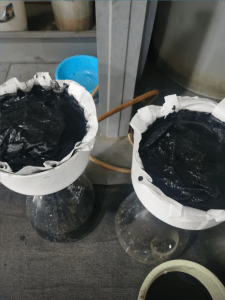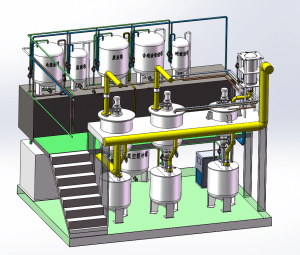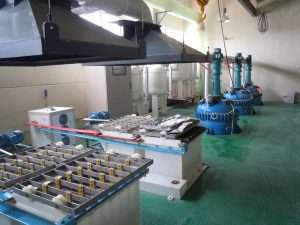Call us now:
Gold electrolysis operation process
A, process conditions
Gold anode plate composition: Au 95% ~ 99%, Ag 0.79% ~ 2.91%, Pb 0.43% ~ 2.5%, Cu 0.010% ~ 0.035%. The tank voltage drop is 0.25~0.50 V, the density of electrolyte is 1.30~1.40 (g/cm3), and the temperature of electrolyte is maintained by the heat generated from the electrolysis process, which can meet the production requirements.
The electrolyte temperature is maintained by the heat generated from the electrolysis process, which can meet the production requirements. Since the initial electrode sheet is thin, the gas stirring device is turned on continuously after 10-12 hours of production, which can avoid the short circuit phenomenon caused by inflation.

II. Process control measures for gold electrolysis
(1) When the electrolysis reaches a certain level, the electrolyte should be measured, if the lead content in the electrolyte rises higher, it will cause the anode to passivate, then it is necessary to add sulfuric acid to remove the lead.
Pb2++SO42- =PbSO4 ↓
(2) Minimize the use of iron tools, stainless steel tools can be used as a last resort, and glass or plastic tools are generally used.
(3) The choice of anode bag material is critical. The material must be acid-resistant and dense to effectively prevent the leakage of fine particles such as silver chloride, thus avoiding the adverse effects of particle drift and adsorption. Before 2000, due to the problem of anode bag material selection, the anode bag oxidation broke during the gold electrolysis process, resulting in the leakage of trace anode sludge and the production of substandard electrolytic gold with excessive impurities as shown in Table 1.
We analyzed this as a quality accident and made corrections to other related factors, while strengthening training for operators and institutionalizing the operation. We have formulated the "Smelting Process Standard", "Gold Electrolysis Operation Specification", "Gold Anode Acceptance Regulations", "Gold Anode Plate Casting Operation" and "Gold Anode Plate Casting Operation".
The company has formulated standardized operation instructions such as "Smelting Process Standard", "Gold Electrolysis Operation Specification", "Gold Anode Acceptance Regulations", "Gold Anode Plate Casting Operation Specification" and "Standard Gold Ingot Production Operation Specification". After the correction, the electrolytic gold and gold ingots produced by our company are better than the Au-1 of GB/T4135- 1994 and are well received by the market.
(4) If the liquid level drops, add deionized water or gold electrolyte in time. After a period of time, out of the electric gold, cut off the lugs, weighed out the wet weight, into the stainless steel dish with dilute nitric acid heating and cooking, the same method as the operation of the first pole piece. At the same time, weigh the starting piece as needed and hang it in the electrolyzer.
At the same time, the first electrode piece is hung into the electrolytic bath as required, and the production continues in the next cycle. The cleaned gold is put into a special stainless steel tray, covered with unprinted white paper, put into a special oven for drying, and after drying, it is measured and put into storage. The finished gold ingots will be obtained later. More gold electrolysis equipment can be contacted by visiting Zhengzhou Jinquan official website.


